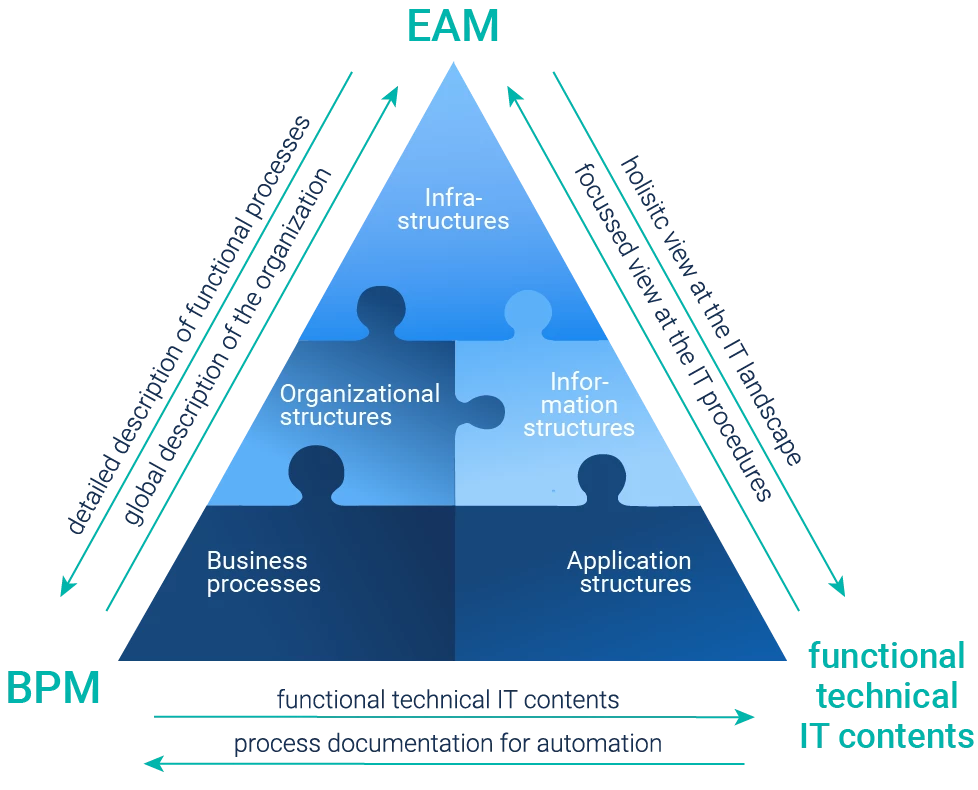BIC Process Design
Understand & Transform
Supercharge your business operations with the most intuitive AI-powered BPM software.
It seems that you come from a German speaking country. Here you can change the language
EnglishCompanies use models in various departments, to find as many answers to corporate questions as possible. What may sound trivial can only hardly be realized, due to complex connections between the departments. Purpose of an integrative model is to find valuable answers on a cross-departmental scale.

The goal in creating models of an organization is to build a sound basis for answers - for example, about the status of a company or to discover problems in specific work activities. To this end, they are applied in various areas of the company, especially in classical business process management (BPM), which uses process models to describe the activities in a company. In addition to process modeling, there are other modeling approaches in related subject areas such as enterprise architecture management (EAM) and functional-technical IT.
The procedure for the description, as well as the notations used, often differ between departments. These differences cause problems in the evaluation. For example, when comparing a process map and an enterprise architecture, it is difficult to draw meaningful conclusions. However, to accurately
describe the current state of activities and structures in a company, it is necessary to analyze across departments.
The integrative approach links the process models from BPM with EAM and IT. This combination of different domains of modeling has an enormous potential for benefits. It makes the diverse elements that have interaction points and interfaces in the company jointly observable by making their object types (processes, roles, applications, etc.) available across domains. Due to the large number of possible objects and interfaces, a targeted, integrative model is difficult to design. How can process models be successfully integrated with EAM and IT?
Figure 1 shows the similarities in content, but also the differences between the notations, which must be overcome. If, for example, EAM content is recorded, then it is inevitable that elements from the other areas must also be included. The same applies to a single process model or a description of the IT architecture. When modeling processes and especially when implementing the integrative approach, it is crucial to avoid redundancies. For this purpose, the modeler determines exactly which content belongs to which area when creating the design.

Process models focus on the process and activities of value creation in the company. Process modeling describes how the participants (roles) go through their activities and which resources are involved in the activities. It is important to document only business, IT-neutral content in the process model.
In addition to the analysis of activities as processes, process modeling serves the business optimization, documentation, and communication of workflows. From the process model, all activities for effective organizational design and further development, as well as for processing and measuring business processes, are derived.
In the enterprise architecture approach, the company models an abstracted version of itself. An overview perspective with a low level of detail depicts the connections and dependencies. The detailed representation of individual contents, as is common in process models, is not done in EAM. It is exclusively an abstract view of the structures and working methods.
The EAM therefore rather models the superordinate levels and neglects to consider the activities in process models. With enterprise architecture, an organization tries to determine how it can achieve its current and future goals in the most effective way. The following contents form the basis of each EA model:
From here, the transparent technical description of an organization and its information technology support are derived.
The central task of mapping functional-technical IT is to document the content that an organization needs to design, implement, and operate IT solutions. The documentation and description requirements of this IT solution (e.g., SAP introduction, robotic process automation or process mining) form the basis to define the model.
Digitization (the digital representation of previously analogously stored data sets) and in particular digital transformation (the exploitation of digital offers to increase corporate success and to open up new potentials) are currently the buzzwords for sustainable management and have given this area additional significance. Even if other buzzwords dominate the discussion in the future, the goal of functional-technical IT modeling will remain: To introduce and operate software and hardware in a problem-related and promising manner.
For this very reason, the technical content of individual IT processes should have the same importance as process models and EAM content. The advantages of novel solutions such as process mining and robotic process automation can only be exploited if knowledge of the individual processes and organization-wide correlations is available. Further examples are such topics as digitalization strategy or IT governance.
In various forms, process modeling, enterprise architecture and functional-technical IT modeling often deal with similar information content. For example, as a first step towards implementing an IT project, the IT analyst needs detailed information about the business context for which he is to design a tailored solution. He must determine and describe this business and technical information. In the next phase, this knowledge forms the basis for management to classify and evaluate the significance of the new solution for the overall corporate strategy.
A comprehensible documentation and communication of the information towards the management level as well as the business and IT departments is essential. Only if the three perspectives BPM, EAM, and IT are linked via an integrative model approach, the modeling provides accurate answers and opens up the possibilities for efficient business planning.
BIC Process Design offers you a variety of notations and enables you to combine different perspectives within your company. Create a common understanding across all stakeholders and gain better insights for your business.

Our innovative BPM tool BIC Process Design ensures more transpareny and smooth work processes. Find out how easy it can be to model your processes, give access to them company-wide and jointly optimize workflows.

BIC Process Design impresses users worldwide with its unique user-friendliness and innovative design. Convince yourself of the powerful functionalities of our BPM software and model your first processes in our trial version.

Head of GBTEC Academy
Christoph isn’t just the head of our GBTEC Academy – he also brings years of experience and deep expertise across our entire product portfolio. For many years, he worked closely with our customers as a consultant. Today, he and his team provide not only product-specific trainings but also help companies and professionals strengthen their skills in a wide range of topics, even beyond our own product offerings.
We have the information you need to unleash your full process potential. Take a look at our resources and start improving your business performance today.